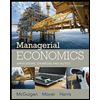
Microeconomics (7th Edition)
7th Edition
ISBN: 9780134737508
Author: R. Glenn Hubbard, Anthony Patrick O'Brien
Publisher: PEARSON
expand_more
expand_more
format_list_bulleted
Textbook Question
Chapter 6, Problem 6.5.3PA
(Retated to Solved Problem 6.5 on page 200) Suppose that the long-run
a. What is the new quantity of gasoline demanded after the tax is imposed? How effective would a gas tax be in reducing consumption of gasoline in the long run?
b. How much does the federal government receive from the tax?
Expert Solution & Answer
Want to see the full answer?
Check out a sample textbook solution
Students have asked these similar questions
Suppose the exchange rate between the British pound and the U.S. dollar is £1 = $2.00.
The
U.S. government implementsU.S. government implements
a contractionary fiscal policya contractionary fiscal policy.
Illustrate the impact of this change in the market for pounds.
1.) Using the line drawing
tool,
draw and label a new demand line.
2.) Using the line drawing
tool,
draw and label a new supply line.
Note: Carefully follow the instructions above and only draw the required objects.
Just Part D please, this is for environmental economics
3. Consider a single firm that manufactures chemicals and generates pollution through its emissions E.
Researchers have estimated the MDF and MAC curves for the emissions to be the following:
MDF = 4E and MAC = 125 – E
Policymakers have decided to implement an emissions tax to control pollution. They are aware that a
constant per-unit tax of $100 is an efficient policy. Yet they are also aware that this policy is not politically
feasible because of the large tax burden it places on the firm. As a result, policymakers propose a two-
part tax:
a per unit tax of $75 for the first 15 units of emissions
an increase in the per unit tax to $100 for all further units of emissions
With an emissions tax, what is the general condition that determines how much pollution the regulated
party will emit?
What is the efficient level of emissions given the above MDF and MAC curves?
What are the firm's total tax payments under the constant $100 per-unit tax?
What is the firm's total cost of compliance…
Chapter 6 Solutions
Microeconomics (7th Edition)
Ch. 6 - Write the formula for the price elasticity of...Ch. 6 - If a 10 percent increase in the price of Cheerios...Ch. 6 - Prob. 6.1.3RQCh. 6 - Prob. 6.1.4RQCh. 6 - Prob. 6.1.5PACh. 6 - Prob. 6.1.6PACh. 6 - Jacob Goldstein, a correspondent for National...Ch. 6 - Prob. 6.1.8PACh. 6 - In 1916, Ford Motor Company sold 500,000 Model T...Ch. 6 - Prob. 6.1.10PA
Ch. 6 - What are the key determinants of the price...Ch. 6 - Prob. 6.2.2RQCh. 6 - Prob. 6.2.3PACh. 6 - According to a news story about the bus system in...Ch. 6 - Prob. 6.2.5PACh. 6 - The price elasticity of demand for crude oil in...Ch. 6 - Prob. 6.2.7PACh. 6 - Prob. 6.3.1RQCh. 6 - Prob. 6.3.2RQCh. 6 - Prob. 6.3.3PACh. 6 - Prob. 6.3.4PACh. 6 - Prob. 6.3.5PACh. 6 - Prob. 6.3.6PACh. 6 - Prob. 6.3.7PACh. 6 - Prob. 6.3.8PACh. 6 - Prob. 6.3.9PACh. 6 - Prob. 6.3.10PACh. 6 - Prob. 6.3.11PACh. 6 - Prob. 6.3.12PACh. 6 - Prob. 6.4.1RQCh. 6 - Prob. 6.4.2RQCh. 6 - Prob. 6.4.3PACh. 6 - Prob. 6.4.4PACh. 6 - Prob. 6.4.5PACh. 6 - Prob. 6.4.6PACh. 6 - Prob. 6.4.7PACh. 6 - (Related to the Apply the Concept on page 199) The...Ch. 6 - Prob. 6.4.9PACh. 6 - Prob. 6.5.1RQCh. 6 - Prob. 6.5.2PACh. 6 - (Retated to Solved Problem 6.5 on page 200)...Ch. 6 - Prob. 6.5.4PACh. 6 - Prob. 6.5.5PACh. 6 - Prob. 6.5.6PACh. 6 - Prob. 6.5.7PACh. 6 - Write the formula for the price elasticity of...Ch. 6 - Prob. 6.6.2RQCh. 6 - Prob. 6.6.3PACh. 6 - Prob. 6.6.4PACh. 6 - Prob. 6.6.5PACh. 6 - Use the midpoint formula for calculating...Ch. 6 - Prob. 6.6.7PACh. 6 - Suppose that on most days, the price of a rose is...Ch. 6 - Use the graph of the market for basketball tickets...Ch. 6 - Prob. 6.2CTE
Knowledge Booster
Learn more about
Need a deep-dive on the concept behind this application? Look no further. Learn more about this topic, economics and related others by exploring similar questions and additional content below.Similar questions
- 2. Answer the following questions as they relate to a fishery: Why is the maximum sustainable yield not necessarily the optimal sustainable yield? Does the same intuition apply to Nathaniel's decision of when to cut his trees? What condition will hold at the equilibrium level of fishing in an open-access fishery? Use a graph to explain your answer, and show the level of fishing effort. Would this same condition hold if there was only one boat in the fishery? If not, what condition will hold, and why is it different? Use the same graph to show the single boat's level of effort. Suppose you are given authority to solve the open-access problem in the fishery. What is the key problem that you must address with your policy?arrow_forward1. Repeated rounds of negotiation exacerbate the incentive to free-ride that exists for nations considering the ratification of international environmental agreements.arrow_forwardFor environmental Economics, A-C Pleasearrow_forward
- True/ False/ Undetermined - Environmental Economics 3. When the MAC is known but there is uncertainty about the MDF, an emissions quota leads to a lower deadweight loss associated with this uncertainty.arrow_forwardTrue/False/U- Environmental Economics 2. The discount rate used in climate integrated assessment models is the key driver of the intensity of emissions reductions associated with optimal climate policy in the model.arrow_forwardAt the beginning of the year, the market for portable electric fans was in equilibrium. In June, a summer heat wave hit. What effect does the heat wave have on the market for fans? Drag the appropriate part(s) of the graph to show the effect on the market for portable fans. To refer to the graphing tutorial for this question type, please click here. Price 17 OF 21 QUESTIONS COMPLETED f4 Q Search f5 f6 f7 CO hp fg 6 M366 W ins f12 f11 f10 SUBMIT ANSWER ENG 4xarrow_forward
- In the context of investment risk, what does "diversification" mean? A) Spreading investments across various assets to reduce riskB) Investing in a single asset to maximize returnsC) Increasing investment in high-risk assetsD) Reducing the number of investments to focus on high-performing onesarrow_forwardAt the 8:10 café, there are equal numbers of two types of customers with the following values. The café owner cannot distinguish between the two types of students because many students without early classes arrive early anyway (that is she cannot price discriminate). Students with early classes Students without early classes Coffee 70 60 Banana 50 100 The MC of coffee is 10. The MC of a banana is 40. Is bundling more profitable than selling separately? HINT: if you sell the bundle, can you make more by offering coffee separately? If so, what price should be charged for the bundle? (Show calculations)arrow_forwardYour marketing department has identified the following customer demographics in the following table. Construct a demand curve and determine the profit maximizing price as well as the expected profit if MC=$1. The number of customers in the target population is 10,000. Use the following demand data: Group Value Frequency Baby boomers $5 20% Generation X $4 10% Generation Y $3 10% `Tweeners $2 10% Seniors $2 10% Others $0 40%arrow_forward
- Your marketing department has identified the following customer demographics in the following table. Construct a demand curve and determine the profit maximizing price as well as the expected profit if MC=$1. The number of customers in the target population is 10,000. Group Value Frequency Baby boomers $5 20% Generation X $4 10% Generation Y $3 10% `Tweeners $2 10% Seniors $2 10% Others $0 40% ur marketing department has identified the following customer demographics in the following table. Construct a demand curve and determine the profit maximizing price as well as the expected profit if MC=$1. The number of customers in the target population is 10,000.arrow_forwardTest Preparation QUESTION 2 [20] 2.1 Body Mass Index (BMI) is a summary measure of relative health. It is calculated by dividing an individual's weight (in kilograms) by the square of their height (in meters). A small sample was drawn from the population of UWC students to determine the effect of exercise on BMI score. Given the following table, find the constant and slope parameters of the sample regression function of BMI = f(Weekly exercise hours). Interpret the two estimated parameter values. X (Weekly exercise hours) Y (Body-Mass index) QUESTION 3 2 4 6 8 10 12 41 38 33 27 23 19 Derek investigates the relationship between the days (per year) absent from work (ABSENT) and the number of years taken for the worker to be promoted (PROMOTION). He interviewed a sample of 22 employees in Cape Town to obtain information on ABSENT (X) and PROMOTION (Y), and derived the following: ΣΧ ΣΥ 341 ΣΧΥ 176 ΣΧ 1187 1012 3.1 By using the OLS method, prove that the constant and slope parameters of the…arrow_forwardQUESTION 2 2.1 [30] Mariana, a researcher at the World Health Organisation (WHO), collects information on weekly study hours (HOURS) and blood pressure level when writing a test (BLOOD) from a sample of university students across the country, before running the regression BLOOD = f(STUDY). She collects data from 5 students as listed below: X (STUDY) 2 Y (BLOOD) 4 6 8 10 141 138 133 127 123 2.1.1 By using the OLS method and the information above derive the values for parameters B1 and B2. 2.1.2 Derive the RSS (sum of squares for the residuals). 2.1.3 Hence, calculate ô 2.2 2.3 (6) (3) Further, she replicates her study and collects data from 122 students from a rival university. She derives the residuals followed by computing skewness (S) equals -1.25 and kurtosis (K) equals 8.25 for the rival university data. Conduct the Jacque-Bera test of normality at a = 0.05. (5) Upon tasked with deriving estimates of ẞ1, B2, 82 and the standard errors (SE) of ẞ1 and B₂ for the replicated data.…arrow_forward
arrow_back_ios
SEE MORE QUESTIONS
arrow_forward_ios
Recommended textbooks for you
 Economics (MindTap Course List)EconomicsISBN:9781337617383Author:Roger A. ArnoldPublisher:Cengage Learning
Economics (MindTap Course List)EconomicsISBN:9781337617383Author:Roger A. ArnoldPublisher:Cengage Learning

 Managerial Economics: Applications, Strategies an...EconomicsISBN:9781305506381Author:James R. McGuigan, R. Charles Moyer, Frederick H.deB. HarrisPublisher:Cengage Learning
Managerial Economics: Applications, Strategies an...EconomicsISBN:9781305506381Author:James R. McGuigan, R. Charles Moyer, Frederick H.deB. HarrisPublisher:Cengage Learning
 Microeconomics: Private and Public Choice (MindTa...EconomicsISBN:9781305506893Author:James D. Gwartney, Richard L. Stroup, Russell S. Sobel, David A. MacphersonPublisher:Cengage Learning
Microeconomics: Private and Public Choice (MindTa...EconomicsISBN:9781305506893Author:James D. Gwartney, Richard L. Stroup, Russell S. Sobel, David A. MacphersonPublisher:Cengage Learning

Economics (MindTap Course List)
Economics
ISBN:9781337617383
Author:Roger A. Arnold
Publisher:Cengage Learning



Managerial Economics: Applications, Strategies an...
Economics
ISBN:9781305506381
Author:James R. McGuigan, R. Charles Moyer, Frederick H.deB. Harris
Publisher:Cengage Learning


Microeconomics: Private and Public Choice (MindTa...
Economics
ISBN:9781305506893
Author:James D. Gwartney, Richard L. Stroup, Russell S. Sobel, David A. Macpherson
Publisher:Cengage Learning
Elasticity of Demand- Micro Topic 2.3; Author: Jacob Clifford;https://www.youtube.com/watch?v=HHcblIxiAAk;License: Standard YouTube License, CC-BY